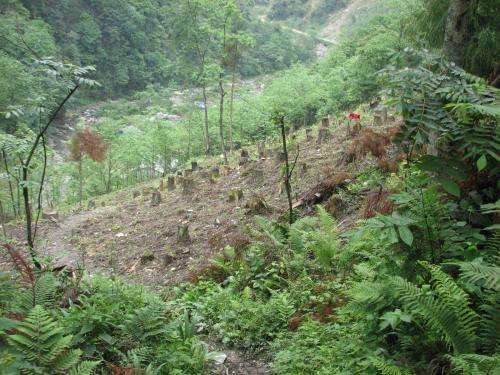This is a logged area in China's Wolong Nature Reserve, an activity being curtailed to encourage forest regrowth. Credit: Wu Yang, Michigan State University Center for Systems Integration and Sustainability
In the past decade, China as sunk some impressive numbers to preserve its forests, but until now there hasn't been much data to give a true picture of how it has simultaneously affected both the people and the environment.
Michigan State University, partnered with the Chinese Academy of Sciences, has capitalized on their long history of research in the Wolong Nature Reserve to get a complete picture of the environmental and socioeconomic effects of payments for ecosystem services programs.
"Performance and prospects of payments for ecosystem services programs: evidence from China" has been published in the Journal of Environmental Management. In it, Wu Yang, a doctoral student in Michigan State University's Center for Systems Integration and Sustainability and center director Jianguo "Jack" Liu, the Rachel Carson Chair in Sustainability, outline the wins and losses in one of the world's richest areas of biodiversity, and home to the endangered giant pandas.
China's tally: $15 billion to ban logging encourage new forests; $32 billion to persuade 32 million rural households to return 8.8 million hectares of cropland back to forest.
The group examined both the people and the environment from as big a picture as trends of the forest from decades of land cover maps, to surveying individual households to understand how their behaviors changed as policies were introduced. Payments for ecosystem services programs – programs in which people were given incentives to change their behavior so the forest around them could recover – have been an enormous effort in China and worldwide.
The work found that China's offering people incentives to change how they live to boost the environment did benefit the forest and the environment – but not without a toll on the people who live there.
The article emphasizes the importance of integrating local conditions and understanding underlying mechanisms to enhance the performance of payments for ecosystem services programs. The article also notes that understanding some of the impacts raises questions for future policy – about whether such policies could be made more efficient, is it ethical to make conservation gains at the cost of people's livelihoods, cultural identity and other issues.
More information: csis.msu.edu/sites/csis.msu.edu/files/Performance%20and%20prospects%20of%20payments%20for%20ecosystem%20services%20programs.pdf
Journal information: Journal of Environmental Management
Provided by Michigan State University























